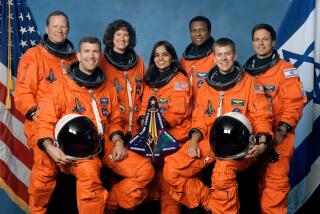Astronaut Questions Rejection of Spacewalk : Shuttle: Flight commander skeptical about NASA’s stance on repairing seal that might block payload doors.
- Share via
HOUSTON — A rare note of discord sounded from the space shuttle Columbia on Saturday when its commander questioned ground engineers on their decision that a spacewalk is not needed to repair a bad seal.
NASA officials downplayed flight commander Bryan D. O’Connor’s skepticism and said that flight controllers, with whom the final decision rests, are convinced that the askew seal poses no danger to the shuttle.
Tests on a shuttle on the ground indicated that the seal, which came loose shortly after Wednesday’s launching, would not prevent the shuttle’s payload doors from closing when the orbiter returns home on Friday, flight director Randy Stone said in a briefing at the Johnson Space Center.
“The absolutely worst case is completely safe,” Stone said. “All the tests have shown the door will close successfully even if the seal is in the worst possible position.”
Thus, Stone said, there will be no spacewalk or practice attempt to close the doors, which are kept open during a mission but are shut just before the shuttle begins its fiery descent to Earth.
O’Connor, when told of this decision, wondered aloud if it was the proper one.
“We are not all that sure that the door will be able to close over that fork (latch) without capturing that environmental seal,” he said.
“I mean, when you look out the back window of the module and look at the TV view, it looks like that seal is hanging right over the top of that fork and will be stuck in between the door and the fork,” O’Connor radioed back to Earth.
Late Saturday, O’Connor read through a detailed report faxed up to Columbia from Mission Control that appeared to satisfy some of his concerns.
“I don’t believe he is skeptical of what the team has done. I think he just wants to understand all of the analysis, which I would do, too, if I were flight commander,” Stone said.
Stone said that O’Connor’s questioning was not as unusual as it appeared to observers on the ground.
“One of the strong points of NASA is its ability to question itself on decisions that are made. There’s a system of checks and balances, and the flight commander is part of it,” he said.
Even if O’Connor insisted that a spacewalk was necessary, he would have to defer to ground controllers here in Houston, according to the National Aeronautics and Space Administration’s chain of command, Stone said.
Stone said that, if the payload bay doors did not close properly, the landing could be delayed and a spacewalk performed by astronauts James P. Bagian and Tamara E. Jernigan.
Meanwhile, the crew continued research into the human body’s response to weightlessness, which is the primary task of this nine-day mission.
Scientists continued to speak in exuberant tones about the data being gathered as crew members provide blood and urine samples, take pictures of their hearts with an imaging device and perform a variety of balance and orientation tests.
“The new word for today is super,” said NASA life sciences director Ron White.
Television pictures beamed down on Saturday, the fourth flight day, showed some jellyfish swimming in circles.
At one point Saturday, astronaut Francis A. (Drew) Gaffney put on blinders and rode a spinning chair in an orientation study related to the treatment of motion sickness, which affects more than half of all space travelers.
Also, Jernigan strapped pilot Sidney M. Gutierrez on to a medical operating table to test equipment that could be necessary on long spaceflights.
More to Read
Sign up for Essential California
The most important California stories and recommendations in your inbox every morning.
You may occasionally receive promotional content from the Los Angeles Times.









